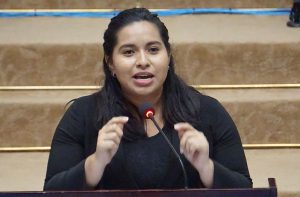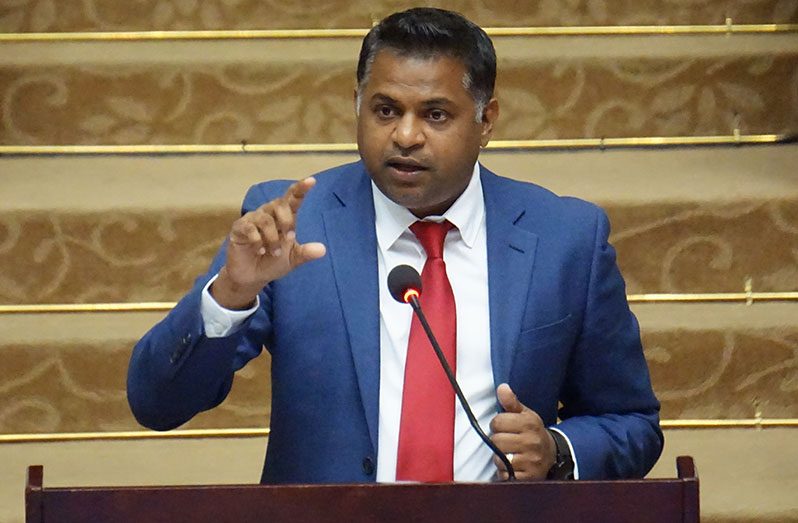— Budget 2021 geared at repairing the ‘wounds’, creating avenue for ‘heathy’ economic advancement
By Navendra Seoraj
DRACONIAN tax measures compounded by imprudent decisions and unconstitutionalities over the past five years have fractured “every bone” in the local economy, leaving the new government with the task of applying a plaster of paris in the form of Budget 2021, to repair those fractures and create a path to healthy economic advancement, Minister within the Ministry of Public Works, Deodat Indar has said.
In a dynamic presentation underpinned by figures and references to past occurrences, Minister Indar took aim at the former A Partnership for National Unity + Alliance For Change (APNU+AFC) Coalition administration’s method of management, which, he said, encompassed heavy taxation and disregard for Guyana’s constitution. He accused the former government, which now occupies the opposition’s side of the National Assembly, of dipping both hands into the pockets of the average Guyanese.
In direct response to opposition Parliamentarian Sherod Duncan’s, claims that the government’s proposed $383.1 billion budget does not cater for small businesses, Minister Indar, on day three of the budget debate, argued that it is quite the opposite as the new government has reversed Coalition-instituted tax measures and other ‘hardship’ measures.

Premising his argument on available information, the minister said that the former Coalition administration had increased taxes by 67 per cent within four years.
“Where is the tax coming from? It is paid by households, employees and businesses… if you take 2015 [$135 billion tax revenue] and come to $226.5 billion [2019 tax revenue], it is a 67 per cent increase… this is the record of the former administration.
“This is their government putting both hands into the pockets of Guyanese… it came from households, businesses and workers… small businesses already had a regime of increased fees and items which moved from zero-rated to standard-rated, all added costs,” Minister Indar reasoned.
He said, therefore, it is an untruth for Duncan to say that the coalition administration had helped small businesses when, in fact, money was extracted from their pockets.
Minister Indar reminded the National Assembly that it was the former coalition administration which instituted value added tax (VAT) on utilities, data, food items, farming, mining and fishing equipment, and herbicides, pesticides and fertilisers. Most of those taxes were removed or reversed when the new government presented Budget 2020 to the National Assembly in September last year.
REVERSAL OF HARDSHIP MEASURES
“When Budget 2020 was presented, we passed the reversal of those measures, those hardship measures,” the minister said.
Prior to the removal or reversal of those measures, the situation as explained by Indar, was one of great economic disparity, as the rate of taxation was higher than the country’s earning capacity.
His reference to this situation was a specific response to opposition Member of Parliament Juretha Fernandes’ argument that the country experienced ‘explosive’ economic growth under the coalition administration.
“She said there was explosive growth of the economy and that the PPP will take years to rebuild that… we recorded a 43.5 per cent increase in GDP [Gross Domestic Product] last years… it has nothing to do with their plan… non-oil economy went down by 7.1 per cent in 2020, so for them to say 2019 was explosive, that is utter nonsense and misleading,” Minister Indar contended.
According to the World Bank, the economy grew 4.4 per cent in 2018 and 5.4 per cent in 2019, but even the latter increase was still lower than the country’s earning capacity, he said.
“They were taxing people at a rate of 13.5 per cent and the economy grew 5.4 per cent… the earning capacity was lower than tax, so they were pauperising the state,” Minister Indar lamented.
Let alone the tax measures, the minister argued that the former administration was starving the people of resources, since the Public Sector Investment Programme (PSIP) was 30 per cent in 2017. His contention was that the coalition had argued in the National Assembly for funds to execute national programmes, but was still sluggish in implementing same.
One particular case of slow implementation was that of the housing aspect of the former Ministry of Communities, which had an implementation rate of 12 per cent.
“To have 12 per cent implementation is institutional laziness,” Minister Indar argued, noting that the same sluggishness will not be replicated by the new government.
TEMPLATE FOR DEVELOPMENT
Using Budget 2021 as an example of the plans in store for Guyanese, the minister said it is a template for development.
Specific to his ministry, Minister Indar said that $39.9 billion, which is 32.9 per cent of the government’s total budgetary allocation for capital works, has been allocated for major infrastructural projects.
In a disaggregation of the intended expenditures, the minister said that $7.9 billion has been set aside for miscellaneous roads, $1.1 billion for urban roads, over $1 billion for the Ogle-Eccles four-lane bypass road, $2 billion for the Sheriff-Mandela expansion project, and $378 million for public and main access roads.
Another $150 million has been allocated for the rehabilitation of the Soesdyke-Linden Highway, while $200 million was set aside for studies on the potential Schoonord to Parika road link.
Minister Indar said too that some $3.5 billion has been budgeted for the Linden-Mabura road project, while $2 billion was budgeted for hinterland roads and $400 million for farm-to-market access roads.
An additional $215 million has also been budgeted for bridges in Better Hope, Cemetery Road, Big and Little Baiboo, Groenveldt and Leonora.
Other allocations include $890 million to purchase 20 pontoons and to rehabilitate span-nine of the Demerara Harbour Bridge, $367 million for the procurement of street lights and construction of sidewalks and parking lots, and $310 million for rehabilitation of the stellings at Wakenaam, Fort Island, Parika, Supenaam and Leguan.
In the aviation sector, $345 million is directed to the rehabilitation of airstrips, while $2.5 billion will fund the further upgrade and modernisation of the Cheddi Jagan International Airport (CJIA).
“This is a template for development… this shows how money is spent to create social and economic formation… this is in keeping with the President’s vision of massive infrastructural development, and his promise to build a modern Guyana,” Minister Indar reasoned.




.png)









